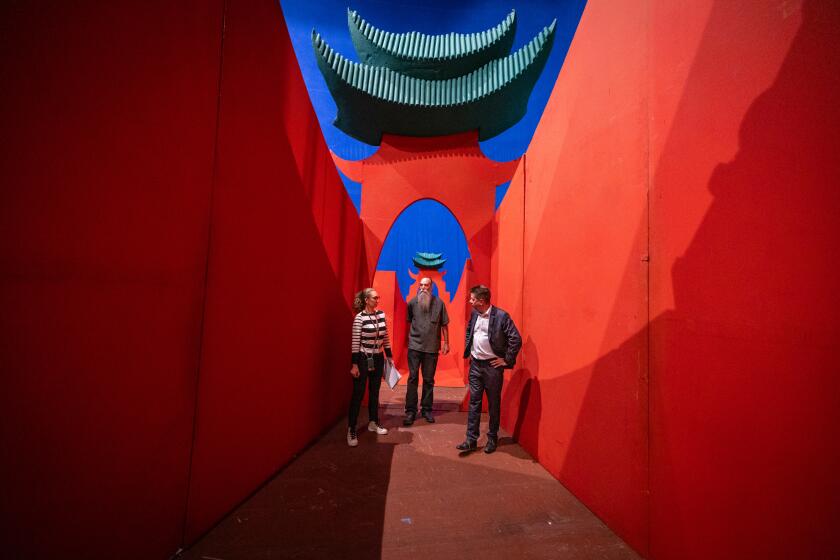ART REVIEWS : Arnoldi’s Mid-Career Re-Emergence
Successful artists rarely re-invent themselves. After all, why bother when one has repute and a standardized product that does well? Charles Arnoldi has been such an artist. For years he has beguiled collectors with wall reliefs made of crisscrossed branches or hewn from wood with a chain saw. He painted too and often not badly, but it was an art that pleased rather than challenged.
For the past three years he’s been closeted in his Venice studio. Only a few intimates were allowed to see what he was up to. Now the work is on public view and the results are invigorating. A competent practitioner in mid-career has transformed himself into a new artist, probing, muscular and seriously engaged.
Heroic dark bronze sculpture are shaped like shells or gnarled tree branches making impossible contortions. Cast from plaster originals, they have surfaces heavily mottled by the artists gouging, dragging fingers. Sometimes the texture doesn’t sit well but he can get that right.
What is impressive here is the release of a heretofore unseen sculptural intelligence. “Home” is nearly 10 feet high and shaped roughly like halves of walnut shell held like cupped hands. A hint of Henry Moore hovers in its earthiness and allusion to the cosmic womb but what makes it gratifying is the palpability of its space. Walk around it and it opens and closes, allowing the eye to sink into its concavities and caress its swelling skin.
If it is a study in the pleasures of grotto and gravity, “Briar Hopper” is a dance. Two simple branch-like verticals mirror one another. As the viewer walks around it they constantly re-engage, doing slow arabesques, dips and turns. Purely contemporary, there is still something of the spirit of Giacometti in it. The work seems inhabited by the shadeof a woman transformed; maybe it ought to be called “Apollo and Daphne.”
It’s also nice to see a sense of humor emerge from the serious Arnoldi. One work looks like a mussel shell that’s been hinged open to sing something out of Lewis Carroll. There’s a bit of wonderland in “Book,” a big tubular husk with a diagonally cut top. It’s like a hollow tree trunk--a cocoon for a good read.
Arnoldi’s two painted aluminum reliefs work fine with their bright biomorphic blobs, but the paintings are downright problematical. All involve loops of black painted over washes. It looks like the artist is trying for the same spatial effects as in the sculpture and is just not quite bringing it off yet.
All the same, the exhibition is enough to make Arnoldi’s critics eat crow. Turns out to be a rather tasty bird.
Fred Hoffman Gallery, 912 Colorado Ave., Santa Monica to May 26.
The Japanese Connection: Sam Francis’ art is revered in Japan. Over there, he’d probably be designated a living national treasure. Over here, he’s respected as among the last survivors of the Abstract Expressionist generation but is too often taken for a very gifted decorative artist whose work never really goes anywhere. Two current Santa Monica gallery exhibitions join the idea of Francis’ Japanese connection and go some way to correct that thinking. Angles gallery has a mini-retrospective sampling the years since 1954. The earliest work is a page of paper splatters that looks like broken necklaces of tiny glass beads. The biggest is a 9x12-foot behemoth that has the effect of an aerial view of Baghdad bombarded with Easter eggs. The most recent looks like Jackson Pollock with the giggles.
Just 10 mostly untitled works are enough to show that Francis is ever-changing rather that inert. He goes about ebulliently exploding grids, liquefying blue blobs and making dull paint tracks look like the Folies Bergere. There’s nothing methodical about his development as there was about Frank Stella’s. Francis likes to sneak up and surprise us with hedonistic insight. He is very Zen in that way.
Zen, of course, believes in the contemplation of the void, which brings us to the show at the Corcoran gallery. It samples his most daring work, the so-called “Edge Series” from 1965-70. These are the works that drive amateurs crazy because they think there is nothing there, just a lot of white canvas framed with dabs of color. Actually, there was a lot on Francis’ mind.
He was thinking about Minimalism and people like Morris Louis. Instead of going at the idea of less-is-more in an Occidental way, he approached it like a series of Zen koan-- elliptical aphorisms about life. An example from 1965 frames blankness in such a fashion as to say, “The Center is Present in Absence.” In 1965, forms moved off the edge to quote Yeats saying, “The Center Will Not Hold.” It’s hard to resist a man who seems to say, “The Void Lies in the Curve of a Hip.”
They are first-rate paintings. They are also a mature artist’s contemplation of the idea of pure white light. In that way, Francis was a forerunner of the now-revered California Light and Space artists. It’s amazing what leaps of intuition can do.
Angles Gallery, 2222 Main St. , James Corcoran Gallery, 1327 5th St.; both exhibitions to May 25.
Inside Out: Two figurative artists present work that seems to be eating itself up from the inside out. Randall Lavender is a talented born-again symbolic Neoclassical painter. There are portraits of himself doing incantatory gestures and images of a nude girl hiding behind a gargoyle. They are disturbingly interesting but the painting keeps going out of whack as if the artist was having trouble keeping his mind on it.
His newest work is better executed. There are landscapes and images of medieval water towers that look like some invented German metaphysical art. They are effective but their wan, desparing colors cause the viewer to have trouble keeping his mind on them. You spend all your time wondering if the artist is feeling OK.
Betty Shelton’s debut solo recalls the spirit of Ivan Albright with his puckered surfaces and hallucinatory realism. Shelton gives us images that talk of the dilemma of being a woman. In one picture she is a dressmaker’s dummy being rebuked by a patriarchal leather chair. The manikin then stands next to a woman sleeping corpse-stiff under a sheet. Then the woman huddles nude in fetal withdrawal. There are passages in both these pictures where the drawing is worthy of Mantegna or a Flemish master, but all too often Shelton’s execution is so compulsive the work looks labored and out of control.
Tortue Gallery, 2917 Santa Monica Blvd. to May 25.
More to Read
The biggest entertainment stories
Get our big stories about Hollywood, film, television, music, arts, culture and more right in your inbox as soon as they publish.
You may occasionally receive promotional content from the Los Angeles Times.






